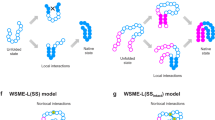Abstract.
Protein secondary structures result both from short-range and long-range interactions. Here neural networks are used to implement a procedure to detect regions of the protein backbone where local interactions have an overwhelming effect in determining the formation of stretches in α-helical conformation. Within the framework of a modular view of protein folding we have argued that these structures correspond to the initiation sites of folding. The hypothesis to be tested in this paper is that sequence identity beside ensuring similarity of the three-dimensional conformation also entails similar folding mechanisms. In particular, we compare the location and sequence variability of the initiation sites extracted from a set of proteins homologous to horse heart cytochrome c. We present evidence that the initiation sites conserve their position in the aligned sequences and exhibit a more reduced variability in the residue composition than the rest of the protein.
Similar content being viewed by others
Author information
Authors and Affiliations
Additional information
Received: 24 April 1998 / Accepted: 4 August 1998 / Published online: 11 November 1998
Rights and permissions
About this article
Cite this article
Compiani, M., Fariselli, P., Martelli, P. et al. Neural networks to study invariant features of protein folding. Theor Chem Acc 101, 21–26 (1999). https://doi.org/10.1007/s002140050400
Issue Date:
DOI: https://doi.org/10.1007/s002140050400




